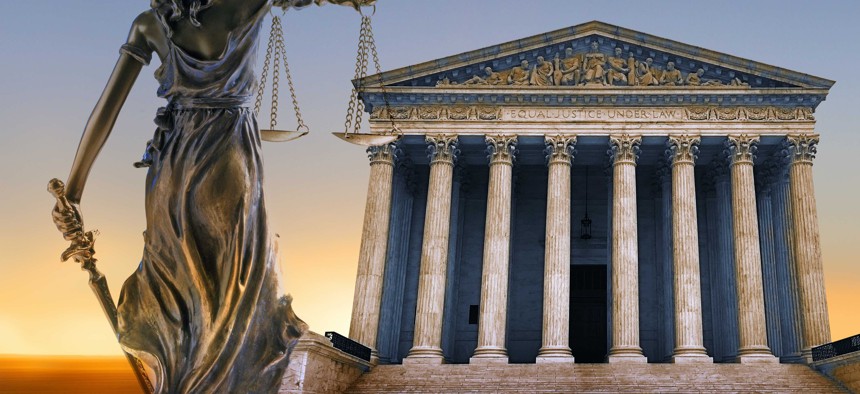The Simple Principle That Can Fix American Law

ISTOCK.COM/DNY59
COMMENTARY | What if a coherent legal philosophy could exist between the poles of living constitutionalism and originalism?
This story was originally published by The Atlantic. Subscribe to the magazine’s newsletters.
Aristotle once observed that “the virtue of justice consists in moderation.” By any measure, he would find little to admire in America’s modern judicial landscape.
In one sense, the problem is simply one of personnel: Precious few judicial moderates serve in America’s federal courts. This absence is most obvious at the Supreme Court, but courts of appeals and district courts suffer from it, too. The researchers Adam Bonica, of Stanford, and Maya Sen, of Harvard, have found, for example, that the present ideological distribution of federal judges resembles an inverted bell curve. We have lots of liberal and conservative judges, but few in between. Gone are the days of jurists like Sandra Day O’Connor, for whom the middle ground was a good place—not one to avoid for fear of being voted down in the Senate or lampooned as a “squish.”
Yet to focus on our nation’s dearth of moderate judges is to scratch at the surface of a much deeper problem. As a field, the law lacks a satisfying, middle-ground response to the core philosophical question that judges must face: By what legal theory should they decide difficult cases—ones in which the law is unclear and where any ruling risks inflaming division among the American people?
Liberal and conservative judicial approaches are, of course, well established. The late Ruth Bader Ginsburg captured the former approach when she testified during her confirmation hearings that the Constitution should be interpreted so as to govern “not just for the passing hour, but for the expanding future.” By contrast, her conservative successor, Amy Coney Barrett, is now the fourth self-professed originalist on the Court.
The rift between living constitutionalism and originalism is not merely an esoteric debate among judges. It is equally salient—and equally partisan—among the broader public. A recent Pew Research poll found that while 88 percent of liberal Democrats believe that the Supreme Court should “base its rulings on what the Constitution means in current times,” 79 percent of conservative Republicans say the Court should “base its rulings on the Constitution’s original meaning.”
But what is the judicial philosophy that occupies the middle ground? There is, of course, no way to split the temporal difference between originalism and living constitutionalism. Either the law’s meaning is fixed in time, or it isn’t. Some prominent academics have worked to re-brand originalism as itself a neutral and centrist approach. But on balance, the results have tended to track conservative views.
What America lacks today, in other words, is a judicial philosophy that can mediate the usual theories advanced on the left and the right. This absence might be every bit as much of a problem for our legal culture and legal system as the absence of centrist judges. Or, rather, it might be the underlying problem altogether. For without a compelling philosophy of judicial moderation, what hope is there for the reemergence of judicial moderates?
Today’s supreme court offers a powerful lens through which to view this dilemma. In the aftermath of Barrett’s confirmation, progressives are fearful of the likely consequences of the Court’s new conservative supermajority. Some have suggested that, putting aside the possibility of eliminating the filibuster and enacting meaningful Court reform, Democrats’ best short-term hope is for two of the Court’s six conservatives to dial back the political temperature and look for centrist solutions in divisive cases. Although the Court has hardly swung left over the past several months, a surprising pattern of decisions suggests that a modest pivot to the middle might well be emerging.
Here is where the absence of a moderate judicial approach becomes crucial moving forward. Suppose Chief Justice John Roberts, whose concern for the Court’s institutional legitimacy is well known, is joined by a second conservative who cares about preserving the Court’s public image. Perhaps it is Justice Brett Kavanaugh, who shocked onlookers with a recent declaration that “the same-sex marriage right recognized in Obergefell” is a “very important right.” Or maybe it is Justice Neil Gorsuch, whose unexpected opinions last term rankled some conservatives. Even Barrett has shown surprising signs of moderation, as her early votes have aligned her closer to the chief justice than to staunch conservatives Clarence Thomas and Samuel Alito.
The trouble is, what comes next? Or, rather, how does a new center emerge? How might a bloc of institutionalist-minded conservative justices vote to reach moderate outcomes in the controversial disputes that come before them?
[Adrian Vermeule: Beyond originalism]
One option would be to pick, choose, and even trade off winners across a range of cases based on the justices’ best guess as to which outcomes would be most politically palatable. In this ad hoc approach, the pursuit of aggregate results approximating some rough vision of centrism would itself be the touchstone for decision—legal reasoning be damned. Indeed, some critics have argued that the Court’s recent centrist pivot is the product of precisely this approach.
This would be a recipe for disaster. Supreme Court justices are poorly equipped to make these kinds of political judgments. Consider Chief Justice Roger Taney’s apparent belief that the Court’s Dred Scott ruling would somehow settle sectional conflict over slavery, thereby averting a civil war. If anything, the justices’ political instincts are even less informed now, given the growing social and economic distance between them and the American public.
Ad hoc rulings of this kind would also suffer from a severe public-reason problem. Faced with the opportunistic and inconsistent rationales put forth by a Court that dresses up its political guesswork from one opinion to the next, the public would soon recognize naked political expediency—not principled legal reasoning—as the Court’s lodestar.
A Supreme Court interested in moderation would do better to explain its decisions in the language of a consistent legal principle. Legal theory offers two traditional contenders: deference to legislatures and stare decisis—deference to the Court’s own prior judgments. Recently, Roberts has drawn on both approaches. He explained his vote to uphold a California COVID-19 response as an exercise of deference owing to the fact that the Court, unlike a legislative body, “is not accountable to the people.” And he defended his surprising vote to strike down a Louisiana abortion regulation in June Medical Services v. Russo by citing stare decisis.
Each of these approaches, however, is beset by problems. As an initial matter, the two doctrines are often internally contradictory. June Medical is itself an example. The chief’s vote to invalidate Louisiana’s admitting-privileges requirement for abortion providers was a textbook application of stare decisis given that the Court had struck down an identical Texas law just four years earlier. Yet following that precedent amounted to a direct rebuke of state legislators.
More fundamentally, legislative deference and stare decisis are inadequate on their own terms. The notion of deference to legislatures grew in appeal during an era when the major question before the Court was whether to second-guess popular New Deal economic regulations. But the doctrine’s infirmity was soon exposed, when, during the civil-rights era, bigoted local and state officials pleaded for deference to racially discriminatory laws. From this perspective, Brown v. Board of Education signaled more than the Court’s overdue intervention in the great racial injustice of segregated public schools; it heralded the rightful end of legislative deference as an overarching principle of judicial review.
A similar problem plagues stare decisis. Like legislative bodies, sometimes the Court makes constitutional errors that require correction. Yet if taken to the extreme, stare decisis would compel the Court to stand by odious rules announced in cases like Plessy v. Ferguson and Korematsu v. United States. Stare decisis, like legislative deference, cannot be an “inexorable command”—a fact the Court itself has stated many times. But once the Court admits that it can discard these doctrines at its pleasure, what constraining role is left for them to play?
All of this points to the fundamental problem that faces the Court’s institutionalist conservatives if they choose to pursue a path of judicial moderation. It is a problem for America’s broader legal culture, too, to the extent that one hopes the polarized segments of American society can ever discover common ground. Does any legal principle exist by which we can find our way there?
The year 2020 will long be remembered as a year of tragic and unparalleled adversity, from the onset of the deadly global pandemic, to glaring reminders of society-wide racial injustice, to Donald Trump’s ill-fated effort to steal the election. But even as we grieved, worried, and mobilized for change, something encouraging happened, unexpectedly, at the Supreme Court: The justices stumbled onto the beginnings of a compelling theory of judicial moderation.
It started last summer, at the end of one of the most monumental terms in recent history. Over a 25-day sprint, the Court handed down high-profile opinions concerning the rights of LGBTQ workers; the fate of hundreds of thousands of undocumented immigrants who had been brought to America as small children; impassioned efforts to obtain Trump’s private financial records; a controversial Louisiana abortion regulation; religious-school vouchers; and whether much of eastern Oklahoma remains an Indian reservation.
These cases raised genuinely difficult legal questions with enormous stakes. And in all of them, the Court’s decisions followed an intriguing logic. Rather than resting solely on some highly debatable conclusion as to a one-and-only “correct” meaning of the law—whether rooted in arguments over original meaning or in evolving precedent or societal values—the Court justified its rulings by pointing to an additional rationale: the goal of minimizing the harm of its decisions. The Court did so in a particular way—by identifying and ruling against the side with the greatest ability to avoid the harm it would suffer in defeat. (I’ve previously called this the “least harm principle.”)
Take, for example, last term’s blockbuster ruling in Bostock v. Clayton County, in which Gorsuch (joined by Roberts) stunned movement conservatives by holding that federal law forbids employment discrimination on the basis of sexual orientation. Much has been written about the particular brand of textualism that Gorsuch employed to reach this outcome, and rightly so. But that commentary has obscured an equally vital piece of Bostock’s reasoning: the opinion’s clear suggestion that, despite their defeat, religious employers have powerful legal options for minimizing their harm moving forward. It is no accident, in other words, that Gorsuch went out of his way to describe the “careful consideration” that such employers would receive in future cases should they request exemptions from federal anti-discrimination law under the free-exercise clause or the Religious Freedom Restoration Act. That is least-harm reasoning at its apex.
The same principle explains Trump v. Mazars. That case involved subpoenas issued by several Democrat-controlled committees in the House of Representatives seeking private financial records from Trump’s bank and accounting firm. The committees argued that the records were needed to inform potential legislation on issues like money laundering and foreign election meddling. The president contested the subpoenas, and the Supreme Court ruled in his favor. Critically, the Court did so because Congress has better options for avoiding the harm of defeat. For unlike Trump (and future officeholders), who would be powerless to avoid the intrusion of such subpoenas, the House could potentially secure the information it needed to legislate from subpoenas to other sources or narrower subpoenas to the president himself.
The Court, to be sure, has not consistently followed this approach; prominent counterexamples include cases in which the Court has upheld state laws burdening voting rights even where those states have other ways to protect their interests. But as I argue in a forthcoming law-review article, the least-harm principle remains firmly grounded in a broad tradition of high-profile decisions in which the Court has consciously bypassed arguments rooted in originalism or evolving social values and ruled instead to ensure that the losing side has ample alternatives to minimize its harm. Promisingly, the Court has shown signs of following this approach in a number of important cases this term, too.
The least-harm principle is moderate in the most logical of ways: By ensuring that losing groups have other avenues for redress, the principle prevents the destructive world President Joe Biden cautioned against in his inaugural address—one in which “every disagreement [is] a cause for total war.” The principle is neutral because the side that is best able to avoid its harm will differ based on the nuanced facts of each case, not political preferences—as cases such as Bostock and Mazars illustrate. And the least-harm principle is intellectually honest because it admits that judges will often be unable to discover clear answers to society’s deepest disagreements using lawyerly arguments about vague, ambiguous, and conflicting sources of legal meaning.
The least-harm approach is also judicially administrable. Consider, for example, the Court’s ruling in the DACA case, which invalidated the Trump administration’s effort to rescind protections for roughly 700,000 “Dreamers” because the administration failed to provide a “reasoned explanation” for its action. It is obvious which side would be better able to avoid the harms of a defeat. Unlike the Dreamers, who would have been powerless to avoid deportation had they lost, the Trump administration had “considerable flexibility,” as the Court pointed out, to rescind DACA, as long as it provided a sufficient explanation.
Opinions like these show how the Court is on the cusp of a powerful new approach for deciding hard cases. Yet the least-harm principle’s future is complicated by the recent change in the Court’s composition. No longer is Chief Justice Roberts, who either authored or joined last term’s prominent least-harm decisions, the median justice. How, then, will we know if the approach retains influence in the coming months?
A major test case currently pending in the Court will be revealing. The question in Fulton v. City of Philadelphia is whether the Constitution entitles a Catholic foster-care agency to an exemption from a general city rule forbidding discrimination on the basis of LGBTQ status. (The Catholic agency refused on religious grounds to certify LGBTQ foster parents.) The Catholic agency is likely to win the case; the major question is how it will do so.
One possibility is that the Court will write in sweeping terms, overruling long-standing precedent to confer a broad religious exemption to engage in LGBTQ discrimination. But the least-harm principle provides a narrower—and superior—ground of decision. Under it, the Court would explain that it is ruling against Philadelphia because the city has a sensible alternative for protecting LGBTQ people’s right to participate as foster parents: The city can compel religious agencies to refer LGBTQ applicants to other agencies that would gladly serve them. In Philadelphia alone, 29 such foster-care agencies exist. But as Kavanaugh implied in oral argument, this middle-ground approach would mean that religious agencies would lose in jurisdictions where no secular agencies were willing to serve LGBTQ applicants—for in such cases the government would lack any way to avoid harm to the LGBTQ community.
To be sure, progressives and conservatives alike might be skeptical of this principle as a first-best solution. To progressives, any defeat for their most cherished values might seem too much to stomach. Many on the right likely feel the same, and understandably so.
But the pursuit of victory by any means is what has brought the Court to this current precipice. To preserve the Court’s legitimacy, both sides of the partisan divide must come to terms with the prospect of some losses. And if that is so, then all Americans should hope for the kind of losses the least-harm principle calls for, where one side doesn’t get what it wanted precisely because it has other ways to protect its interests.
The greatest virtue of the least-harm principle, then, might be its potential to remind the American people that Supreme Court decisions are not the end of the road. Under it, losing groups retain the power to remedy the harms they suffer. A legal philosophy that awakens the people’s own sense of agency might not be the best that progressives or conservatives can hope for separately. But it might be the best they can hope for together: a legally and morally attractive judicial middle ground, where one has been missing for far too long.
Aaron Tang is a professor of law at the University of California, Davis.
NEXT STORY: Vaccinating the Vulnerable, One Church at a Time





